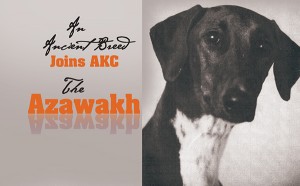An Ancient Breed Joins AKC – The Azawakh
Click here to read the complete article
84 – May, 2020
Purebred is a tricky term. I mean even AKC gets it wrong once in awhile; yeah they do. We all want accuracy but on the other hand, it’s that genetic ebb and flow that keeps breeds vibrant and evolving. The true beauty of our purebred infrastructure is that long after the forces responsible for shaping type have disappeared, that ideal remains reliably anchored to key traits. And let’s face it; most breeds eventually outlive their original function. Repositioning them in today’s canine landscape is an ongoing challenge.
I don’t need to preach to the choir, but as the anti-purebred fanatics are slowly realizing, predictability is a priceless commodity in terms of health, temperament and basically everything responsible for that seamless fit that defines the human/canine bond.
So welcome the Azawakh.
The first specimens arrived here in the 1980s, just as America’s rare breed scene was really taking off. Breeds like the Shar-Pei, Shiba, and Neo grabbed most of the attention, but the Azawakh was there and it soon attracted a hardcore fan base.
Most of the early imports came from Switzerland, Germany, France, and the former Yugoslavia. And the breed’s history in FCI exemplifies the genetic identity crisis that has governed its transition to purebred status. That saga began in the 1950s when Europeans first encountered Azawakhs bred by tribes of the southern Sahara. Their animals represented their survival and in that sense, function, rather than esthetics had guided the Azawakh’s evolution. It’s generally agreed that these groups had cultivated the breed since the sixteenth century. However, it’s also fair to say that natural selection played an equal role in shaping this rugged, versatile hound, ideally adapting it to a very unforgiving environment.
The earliest European imports came from and around Menaka, a region on the border of modern-day Niger. Once a thriving commercial hub, it’s been sunk in conflict for a century. That alone guaranteed some challenges verifying details about its origin.
The term Azawakh came courtesy of France, which became the breed’s patron country for the FCI recognition process. Mali, a French colony until 1960, was designated as its official country of origin, although this is a loose definition since national borders have shifted along with the evolving gene pool over centuries.
Click here to read the complete article
84 – May, 2020
Short URL: http://caninechronicle.com/?p=183282
Comments are closed













